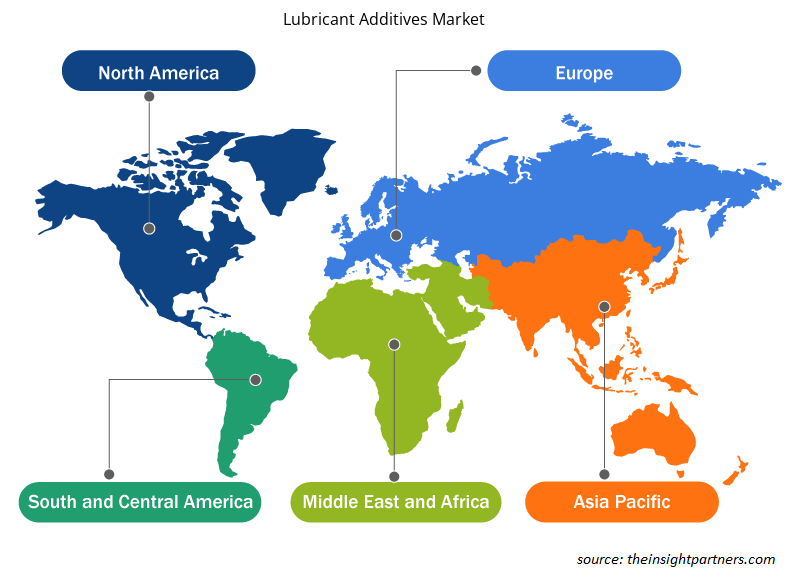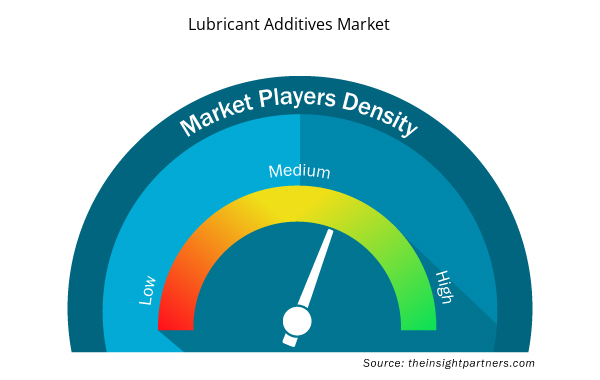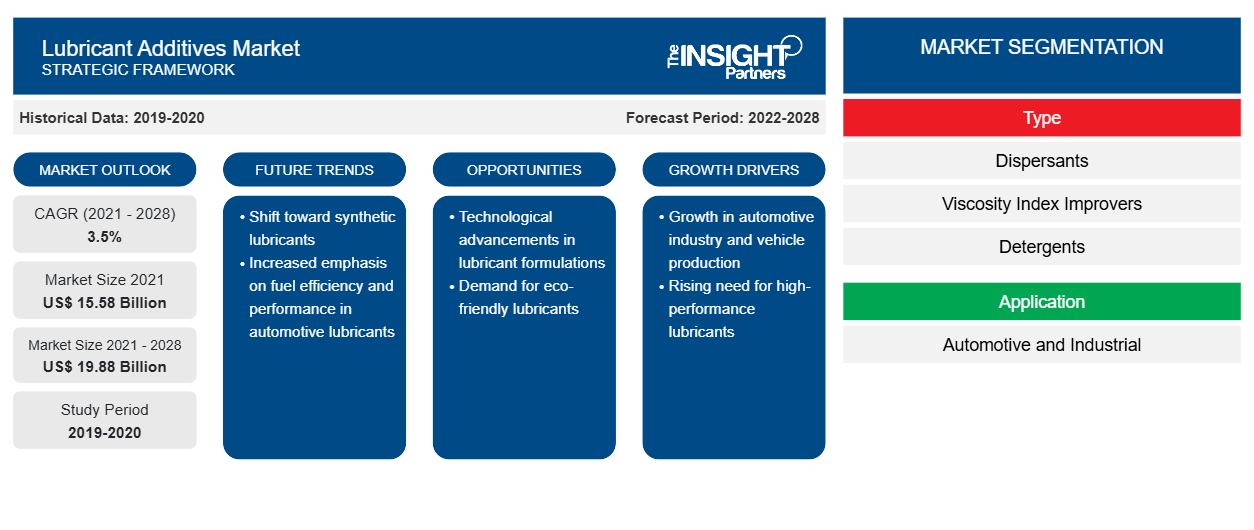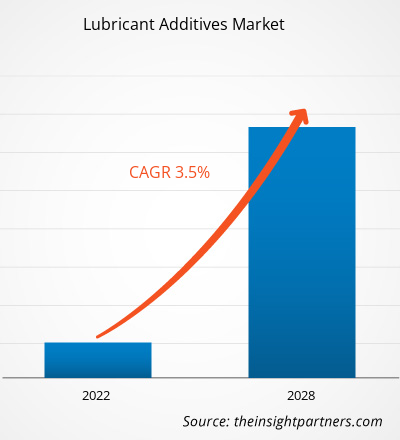Il mercato degli additivi per lubrificanti è stato valutato a 15.584,9 milioni di dollari nel 2021 e si prevede che raggiungerà i 19.880,12 milioni di dollari entro il 2028; si prevede che registrerà un CAGR del 3,5% dal 2021 al 2028.
Gli additivi lubrificanti sono utilizzati nella lavorazione di lubrificanti sintetici, comunemente utilizzati nei settori industriale e automobilistico per le loro caratteristiche superiori all'olio minerale naturale. Pertanto, la crescita dei settori industriale e automobilistico aumenta la domanda di lubrificanti sintetici. L'olio motore è il lubrificante più comunemente utilizzato nei settori automobilistico e industriale. Ha eccellenti proprietà fisiche e chimiche, tra cui un indice di viscosità più elevato, una minore volatilità, un punto di scorrimento e una maggiore stabilità termica. L'aggiunta di additivi come modificatori di viscosità e depressori del punto di scorrimento nei lubrificanti ne migliora le proprietà fisiche e chimiche. Pertanto, l'ampia applicazione di lubrificanti in vari settori è il fattore chiave che guida il mercato degli additivi per lubrificanti poiché la miscelazione di lubrificanti con additivi ne migliora le prestazioni e la durata.
Nel 2020, l'Asia Pacifica deteneva la quota maggiore del mercato globale degli additivi per lubrificanti . Il fattore principale che contribuisce alla crescita del mercato in questa regione è la crescente domanda di additivi per lubrificanti da parte dell'industria automobilistica e di altre industrie manifatturiere. Il crescente sviluppo di parti e componenti per autoveicoli nella regione con l'aumento della produzione di veicoli, unito alle continue innovazioni dei produttori di carburante per autoveicoli, crea opportunità redditizie per il mercato dei lubrificanti, che, a sua volta, guida la crescita del mercato. Inoltre, le crescenti attività di costruzione, soprattutto in Cina e India, probabilmente attireranno gli operatori del mercato globale a stabilire le loro attività nell'Asia Pacifica. I veicoli commerciali pesanti sono ampiamente utilizzati in Cina poiché i consumatori li preferiscono per la loro elevata capacità di carico e i robusti sistemi di sospensione. Pertanto, sono utili nelle attività di trasporto. I veicoli commerciali pesanti, ad esempio i camion, sono ampiamente utilizzati nella logistica, nell'edilizia e nell'agricoltura per la loro elevata capacità di carico. Sono utilizzati principalmente per il trasporto di detriti e materiali da una posizione all'altra su qualsiasi terreno. Tutti questi fattori guideranno la domanda di mercato di additivi per lubrificanti.
Personalizza questo report in base alle tue esigenze
Riceverai la personalizzazione gratuita di qualsiasi report, comprese parti di questo report, o analisi a livello nazionale, pacchetto dati Excel, oltre a usufruire di grandi offerte e sconti per start-up e università
- Scopri le principali tendenze di mercato in questo rapporto.Questo campione GRATUITO includerà analisi di dati che spaziano dalle tendenze di mercato alle stime e alle previsioni.
Impatto della pandemia di COVID-19 sul mercato degli additivi lubrificanti
La pandemia di COVID-19 ha avuto un impatto grave sul mercato globale nel 2020 a causa delle catene di fornitura interrotte delle materie prime utilizzate nella produzione di additivi per lubrificanti. L'allentamento delle misure di lockdown in diversi paesi e la ripresa delle attività operative in molti settori hanno contribuito alla ripresa della domanda di additivi per lubrificanti a partire dal 2021. Inoltre, il ritmo rapido dei programmi di vaccinazione contro il COVID-19 ha sostenuto la crescita del mercato degli additivi per lubrificanti.
Approfondimenti di mercato
La rapida crescita industriale favorisce la crescita del mercato degli additivi lubrificanti
I lubrificanti sono tra i componenti chiave utilizzati nel settore industriale, in quanto aiutano le apparecchiature a funzionare ad alta efficienza e con la massima affidabilità. Lubrificanti minerali e sintetici, grassi, oli per compressori e fluidi da taglio sono diversi tipi di lubrificanti che vengono utilizzati come additivi nei settori automobilistico, petrolifero e del gas, tessile, del vetro, della produzione di energia, della carta e della cellulosa, chimico e petrolchimico, agricolo, manifatturiero, alimentare e delle bevande e farmaceutico, tra gli altri. La crescita di questi settori in tutto il mondo si traduce nella generazione di un'enorme domanda di lubrificanti, nonché di additivi per lubrificanti. I settori della finitura tessile, in particolare nell'area Asia-Pacifico, generano un'elevata domanda di lubrificanti industriali. C'è un'elevata domanda di lubrificanti industriali da parte delle industrie tessili nell'area Asia-Pacifico. Pertanto, l'ampia applicazione di lubrificanti in vari settori e la rapida crescita nel settore industriale sono i fattori chiave che guidano il mercato degli additivi per lubrificanti.
Approfondimenti sulle applicazioni
In base all'applicazione, il mercato è segmentato in automotive e industriale. Il segmento automotive ha detenuto una quota di mercato maggiore nel 2020. Gli additivi lubrificanti sono utilizzati nell'olio motore e nell'olio motore per prevenire la flocculazione di sostanze inorganiche nell'olio al momento del funzionamento. C'è un'elevata domanda di additivi lubrificanti negli oli motore multigrado, negli oli per ingranaggi, nei fluidi per trasmissioni automatiche, nei fluidi per servosterzo, nei grassi e in alcuni fluidi idraulici per mantenere la viscosità ad alta temperatura. Molti produttori di automobili stanno investendo nel miglioramento dell'efficienza del carburante dei veicoli, il che probabilmente contribuirà ulteriormente alla crescita del mercato nei prossimi anni.
Alcuni dei principali attori del mercato degli additivi lubrificanti sono Evonik Industries AG; The Lubrizol Corporation; LANXESS, Nouryon; Mol-lub Kft.; Dover Chemical Corporation; Croda International plc; Chevron Corporation; BASF SE; ed EXXON MOBIL CORPORATION. Queste aziende forniscono un'ampia gamma di portafogli di prodotti per il mercato degli additivi lubrificanti. Queste aziende sono presenti nelle regioni in via di sviluppo, il che offre un'opportunità redditizia per gli additivi lubrificanti. Questi attori del mercato sono altamente concentrati sullo sviluppo di prodotti innovativi e di alta qualità per soddisfare i requisiti del cliente.
Segnala i riflettori
- Tendenze industriali progressive nel mercato degli additivi lubrificanti per aiutare gli operatori a sviluppare strategie efficaci a lungo termine
- Strategie di crescita aziendale adottate dai mercati sviluppati e in via di sviluppo
- Analisi quantitativa del mercato degli additivi lubrificanti dal 2019 al 2028
- Stima della domanda globale di additivi lubrificanti
- Analisi delle cinque forze di Porter per illustrare l'efficacia di acquirenti e fornitori nel mercato degli additivi lubrificanti
- Sviluppi recenti per comprendere lo scenario competitivo del mercato
- Tendenze e prospettive del mercato, nonché fattori che guidano e frenano la crescita del mercato degli additivi lubrificanti
- Assistenza nel processo decisionale evidenziando le strategie di mercato che sostengono l'interesse commerciale
- La dimensione del mercato degli additivi lubrificanti in vari nodi
- Panoramica dettagliata e segmentazione del mercato, nonché dinamiche del settore degli additivi lubrificanti
- Dimensioni del mercato degli additivi lubrificanti in varie regioni con promettenti opportunità di crescita
Approfondimenti regionali sul mercato degli additivi lubrificanti
Le tendenze regionali e i fattori che influenzano il mercato degli additivi lubrificanti durante il periodo di previsione sono stati ampiamente spiegati dagli analisti di Insight Partners. Questa sezione discute anche i segmenti e la geografia del mercato degli additivi lubrificanti in Nord America, Europa, Asia Pacifico, Medio Oriente e Africa e America meridionale e centrale.

- Ottieni i dati specifici regionali per il mercato degli additivi lubrificanti
Ambito del rapporto di mercato sugli additivi lubrificanti
| Attributo del report | Dettagli |
|---|---|
| Dimensioni del mercato nel 2021 | 15,58 miliardi di dollari USA |
| Dimensioni del mercato entro il 2028 | 19,88 miliardi di dollari USA |
| CAGR globale (2021 - 2028) | 3,5% |
| Dati storici | 2019-2020 |
| Periodo di previsione | 2022-2028 |
| Segmenti coperti | Per tipo
|
| Regioni e Paesi coperti | America del Nord
|
| Leader di mercato e profili aziendali chiave |
|
Densità degli attori del mercato: comprendere il suo impatto sulle dinamiche aziendali
Il mercato degli additivi lubrificanti sta crescendo rapidamente, spinto dalla crescente domanda degli utenti finali dovuta a fattori quali l'evoluzione delle preferenze dei consumatori, i progressi tecnologici e una maggiore consapevolezza dei benefici del prodotto. Con l'aumento della domanda, le aziende stanno ampliando le loro offerte, innovando per soddisfare le esigenze dei consumatori e capitalizzando sulle tendenze emergenti, il che alimenta ulteriormente la crescita del mercato.
La densità degli operatori di mercato si riferisce alla distribuzione di aziende o società che operano in un particolare mercato o settore. Indica quanti concorrenti (operatori di mercato) sono presenti in un dato spazio di mercato in relazione alle sue dimensioni o al valore di mercato totale.
Le principali aziende che operano nel mercato degli additivi lubrificanti sono:
- Evonik Industries AG
- La società Lubrizol
- LANXESS
- Nourion
- Mol-lub Kft.
Disclaimer : le aziende elencate sopra non sono classificate secondo un ordine particolare.

- Ottieni una panoramica dei principali attori del mercato degli additivi lubrificanti
Mercato degli additivi lubrificanti
Tipo
- Disperdenti
- Miglioratori dell'indice di viscosità
- Detergenti
- Agente antiusura
- Emulsionanti
- Altri
Applicazione
- Automobilistico
- Industriale
Profili aziendali
- Evonik Industries AG
- La società Lubrizol
- LANXESS
- Nourion
- Mol-lub Kft.
- Società chimica Dover
- Croda International S.p.A.
- Società Chevron
- BASF SE
- Società mobile Exxon
- Analisi storica (2 anni), anno base, previsione (7 anni) con CAGR
- Analisi PEST e SWOT
- Valore/volume delle dimensioni del mercato - Globale, regionale, nazionale
- Industria e panorama competitivo
- Set di dati Excel


- Small Molecule Drug Discovery Market
- Clinical Trial Supplies Market
- Trade Promotion Management Software Market
- Semiconductor Metrology and Inspection Market
- Integrated Platform Management System Market
- Industrial Inkjet Printers Market
- Medical and Research Grade Collagen Market
- Aquaculture Market
- Public Key Infrastructure Market
- Molecular Diagnostics Market

Report Coverage
Revenue forecast, Company Analysis, Industry landscape, Growth factors, and Trends

Segment Covered
This text is related
to segments covered.

Regional Scope
North America, Europe, Asia Pacific, Middle East & Africa, South & Central America

Country Scope
This text is related
to country scope.
Domande frequenti
The dispersants segment held the largest market share. Dispersants are the highest volume additive used in crankcase lubricants and, with treat rates in heavy-duty vehicles and in passenger cars. Dispersants control sludge and varnish build-up by preventing the formation of large structures that could lead to gel formation, and by inhibiting their phase separation from the oil onto engine surfaces.
The major players operating in the global lubricant additives market are Evonik Industries AG; The Lubrizol Corporation; LANXESS, Nouryon; Mol-lub Kft.; Dover Chemical Corporation; Croda International plc; Chevron Corporation; BASF SE; and EXXON MOBIL CORPORATION
The automotive segment held the largest share of the market in 2021. The automotive sector has witnessed tremendous growth in the last decade and is expected to rise steadily during the forecast period. As per the data of Organisation Internationale des Constructeurs d'Automobiles (OICA), the American countries recorded over ~16.2 million commercial & passenger car production in 2010, and this production rate has grown by more than 23% and registered over ~20 million commercial & passenger production in 2019. The automotive industry in China has been growing rapidly and the country is playing an increasingly important role in the global automotive market. With increasing regulatory pressure on improving the fuel efficiency of vehicles and reducing greenhouse gas emissions, there has been a remarkable development in lubricating oil formulations.
Asia Pacific is estimated to register the fastest CAGR in the global lubricant additives market over the forecast period. The development of automotive parts and components in the region with the rise of electric vehicle production has created lucrative opportunities for lubricant additives. Extensive innovation and prototyping from major automakers coupled with consumer preference are some of the factors driving the market growth.
The industrial segment is estimated to register fastest CAGR in the global lubricant additives market. Lubricant is one of the key components used in the industrial sector, which helps keep the equipment operating at peak efficiency and with maximum reliability. There are numerous types of lubricants such as mineral and synthetic lubricants, greases, compressor oils, and cutting fluids that contain additives used across various industries, including automotive, oil & gas, textile, glass, power generation, paper & pulp, chemicals & petrochemicals, agriculture, manufacturing, food & beverages, and pharmaceuticals. The growth of these industries across the globe creates a huge demand for lubricants, this, in turn creates demand for lubricant additives.
In 2021, Asia Pacific held the largest share of the global lubricant additives market. The rise in the number of on-fleet vehicles in countries like China, India and South Korea has fueled the demand for lubricant additives. Increasing awareness regarding fuel economy will propel the demand for lubricant additives in the Asia Pacific.
The List of Companies - Lubricant Additives Market
- Evonik Industries AG
- The Lubrizol Corporation
- LANXESS
- Nouryon
- Mol-lub Kft.
- Dover Chemical Corporation
- Croda International plc
- Chevron Corporation
- BASF SE
- EXXON MOBIL CORPORATION
The Insight Partners performs research in 4 major stages: Data Collection & Secondary Research, Primary Research, Data Analysis and Data Triangulation & Final Review.
- Data Collection and Secondary Research:
As a market research and consulting firm operating from a decade, we have published and advised several client across the globe. First step for any study will start with an assessment of currently available data and insights from existing reports. Further, historical and current market information is collected from Investor Presentations, Annual Reports, SEC Filings, etc., and other information related to company’s performance and market positioning are gathered from Paid Databases (Factiva, Hoovers, and Reuters) and various other publications available in public domain.
Several associations trade associates, technical forums, institutes, societies and organization are accessed to gain technical as well as market related insights through their publications such as research papers, blogs and press releases related to the studies are referred to get cues about the market. Further, white papers, journals, magazines, and other news articles published in last 3 years are scrutinized and analyzed to understand the current market trends.
- Primary Research:
The primarily interview analysis comprise of data obtained from industry participants interview and answers to survey questions gathered by in-house primary team.
For primary research, interviews are conducted with industry experts/CEOs/Marketing Managers/VPs/Subject Matter Experts from both demand and supply side to get a 360-degree view of the market. The primary team conducts several interviews based on the complexity of the markets to understand the various market trends and dynamics which makes research more credible and precise.
A typical research interview fulfils the following functions:
- Provides first-hand information on the market size, market trends, growth trends, competitive landscape, and outlook
- Validates and strengthens in-house secondary research findings
- Develops the analysis team’s expertise and market understanding
Primary research involves email interactions and telephone interviews for each market, category, segment, and sub-segment across geographies. The participants who typically take part in such a process include, but are not limited to:
- Industry participants: VPs, business development managers, market intelligence managers and national sales managers
- Outside experts: Valuation experts, research analysts and key opinion leaders specializing in the electronics and semiconductor industry.
Below is the breakup of our primary respondents by company, designation, and region:

Once we receive the confirmation from primary research sources or primary respondents, we finalize the base year market estimation and forecast the data as per the macroeconomic and microeconomic factors assessed during data collection.
- Data Analysis:
Once data is validated through both secondary as well as primary respondents, we finalize the market estimations by hypothesis formulation and factor analysis at regional and country level.
- Macro-Economic Factor Analysis:
We analyse macroeconomic indicators such the gross domestic product (GDP), increase in the demand for goods and services across industries, technological advancement, regional economic growth, governmental policies, the influence of COVID-19, PEST analysis, and other aspects. This analysis aids in setting benchmarks for various nations/regions and approximating market splits. Additionally, the general trend of the aforementioned components aid in determining the market's development possibilities.
- Country Level Data:
Various factors that are especially aligned to the country are taken into account to determine the market size for a certain area and country, including the presence of vendors, such as headquarters and offices, the country's GDP, demand patterns, and industry growth. To comprehend the market dynamics for the nation, a number of growth variables, inhibitors, application areas, and current market trends are researched. The aforementioned elements aid in determining the country's overall market's growth potential.
- Company Profile:
The “Table of Contents” is formulated by listing and analyzing more than 25 - 30 companies operating in the market ecosystem across geographies. However, we profile only 10 companies as a standard practice in our syndicate reports. These 10 companies comprise leading, emerging, and regional players. Nonetheless, our analysis is not restricted to the 10 listed companies, we also analyze other companies present in the market to develop a holistic view and understand the prevailing trends. The “Company Profiles” section in the report covers key facts, business description, products & services, financial information, SWOT analysis, and key developments. The financial information presented is extracted from the annual reports and official documents of the publicly listed companies. Upon collecting the information for the sections of respective companies, we verify them via various primary sources and then compile the data in respective company profiles. The company level information helps us in deriving the base number as well as in forecasting the market size.
- Developing Base Number:
Aggregation of sales statistics (2020-2022) and macro-economic factor, and other secondary and primary research insights are utilized to arrive at base number and related market shares for 2022. The data gaps are identified in this step and relevant market data is analyzed, collected from paid primary interviews or databases. On finalizing the base year market size, forecasts are developed on the basis of macro-economic, industry and market growth factors and company level analysis.
- Data Triangulation and Final Review:
The market findings and base year market size calculations are validated from supply as well as demand side. Demand side validations are based on macro-economic factor analysis and benchmarks for respective regions and countries. In case of supply side validations, revenues of major companies are estimated (in case not available) based on industry benchmark, approximate number of employees, product portfolio, and primary interviews revenues are gathered. Further revenue from target product/service segment is assessed to avoid overshooting of market statistics. In case of heavy deviations between supply and demand side values, all thes steps are repeated to achieve synchronization.
We follow an iterative model, wherein we share our research findings with Subject Matter Experts (SME’s) and Key Opinion Leaders (KOLs) until consensus view of the market is not formulated – this model negates any drastic deviation in the opinions of experts. Only validated and universally acceptable research findings are quoted in our reports.
We have important check points that we use to validate our research findings – which we call – data triangulation, where we validate the information, we generate from secondary sources with primary interviews and then we re-validate with our internal data bases and Subject matter experts. This comprehensive model enables us to deliver high quality, reliable data in shortest possible time.


 Ottieni un campione gratuito per questo repot
Ottieni un campione gratuito per questo repot